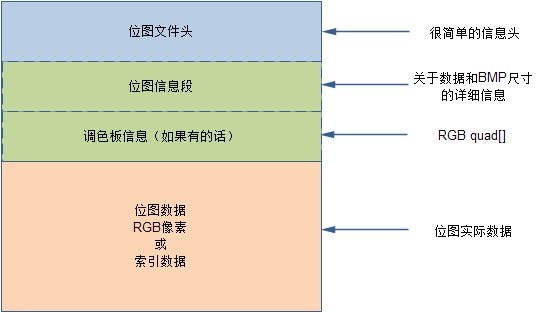在Linux系统中,使用framebuffer来提供用户态进程直接操作显示屏的功能.
在嵌入式系统开发中,需要对显示屏的内容进行截取,实现一个lcd截屏工具实现对显示屏内容的截取,存储为bmp格式.
一个bmp文件有四部分组成:

其中位图文件头内容如下:
WORD bfType;
DWORD bfSize;
WORD bfReserved1;
WORD bfReserved2;
DWORD bfOffBits;
| bfType | 说明文件的类型,该值必需是0x4D42,也就是字符'BM',否则表示根本不是BMP |
| bfSize | 说明该位图文件的大小,用字节为单位 |
| bfReserved1 | 保留,必须设置为0 |
| bfReserved2 | 保留,必须设置为0 |
| bfOffBits | 说明从文件头开始到实际的图象数据之间的字节的偏移量。这个参数是非常有用的,因为位图信息头和调色板的长度会根据不同情况而变化,所以你可以用这个偏移值迅速的从文件中读取到位数据。 |
位图信息段内容如下:
DWORD biSize;
LONG biWidth;
LONG biHeight;
WORD biPlanes;
WORD biBitCount
DWORD biCompression;
DWORD biSizeImage;
LONG biXPelsPerMeter;
LONG biYPelsPerMeter;
DWORD biClrUsed;
DWORD biClrImportant;
| biSize | 说明BITMAPINFOHEADER结构所需要的字节数 |
| biWidth | 说明图象的宽度,以象素为单位 |
| biHeight | 说明图象的高度,以象素为单位。注:这个值除了用于描述图像的高度之外,它还有另一个用处,就是指明该图像是倒向的位图,还是正向的位图。如果该值是一个正数,说明图像是倒向的,即:数据的第一行其实是图像的最后一行,如果该值是一个负数,则说明图像是正向的。大多数的BMP文件都是倒向的位图,也就是时,高度值是一个正数。 |
| biPlanes | 表示bmp图片的平面属,显然显示器只有一个平面,所以恒等于1 |
| biBitCount | 说明比特数/象素,其值为1、4、8、16、24、或32。 |
| biCompression |
说明图象数据压缩的类型,其中: BI_RGB:没有压缩 BI_RLE8:每个象素8比特的RLE压缩编码,压缩格式由2字节组成(重复象素计数和颜色索引); BI_RLE4:每个象素4比特的RLE压缩编码,压缩格式由2字节组成 BI_BITFIELDS:每个象素的比特由指定的掩码决定。 BI_JPEG:JPEG格式 |
| biSizeImage | 说明图象的大小,以字节为单位。当用BI_RGB格式时,可设置为0。 |
| biXPelsPerMeter | 说明水平分辨率,用象素/米表示。 |
| biYPelsPerMeter | 说明垂直分辨率,用象素/米表示。 |
| biClrUsed | 说明位图实际使用的彩色表中的颜色索引数(设为0的话,则说明使用所有调色板项)。 |
| biClrImportant | 说明对图象显示有重要影响的颜色索引的数目,如果是0,表示都重要。 |
由于当前嵌入式设备使用的显示接口为RGB565格式,选择biBitCount为16的格式来存储显示屏数据.显示屏大小为800x600.
实现代码如下:
#include <sys/types.h>
#include <sys/stat.h>
#include <fcntl.h>
#include <sys/ioctl.h>
#include <sys/soundcard.h>
#include <stdio.h>
#include <unistd.h>
#include <math.h>
#include <string.h>
#include <stdlib.h>
static unsigned char sg_BHeader[] = {
0x42, 0x4D, 0x36, 0x58, 0x02, 0x00, 0x00, 0x00, 0x00, 0x00, 0x36, 0x00, 0x00, 0x00, 0x28, 0x00,
0x00, 0x00, 0x40, 0x01, 0x00, 0x00, 0xF0, 0x00, 0x00, 0x00, 0x01, 0x00, 0x10, 0x00, 0x00, 0x00,
0x00, 0x00, 0x00, 0x00, 0x00, 0x00, 0x00, 0x00, 0x00, 0x00, 0x00, 0x00, 0x00, 0x00, 0x00, 0x00,
0x00, 0x00, 0x00, 0x00, 0x00, 0x00
};
#define RGB565TO1555(rgb) ((unsigned short)((unsigned short)(rgb & 0x001f) | ((unsigned short)(rgb & 0xffc0) >> 1)))
void SaveBMPFile(unsigned char *raw, char *filename)
{
unsigned short *p = (unsigned short *)raw;
typedef unsigned int UINT;
typedef unsigned char UCHAR;
UINT m_Width = 800, m_Height = 480;
UINT i, j;
int bmp = open(filename, O_WRONLY | O_CREAT);
if(bmp < 0)
return;
sg_BHeader[0x02] = (UCHAR)(m_Width * m_Height * 2 + 0x36) & 0xff;
sg_BHeader[0x03] = (UCHAR)((m_Width * m_Height * 2 + 0x36) >> 8) & 0xff;
sg_BHeader[0x04] = (UCHAR)((m_Width * m_Height * 2 + 0x36) >> 16) & 0xff;
sg_BHeader[0x05] = (UCHAR)((m_Width * m_Height * 2 + 0x36) >> 24) & 0xff;
sg_BHeader[0x12] = (UCHAR)m_Width & 0xff;
sg_BHeader[0x13] = (UCHAR)(m_Width >> 8) & 0xff;
sg_BHeader[0x14] = (UCHAR)(m_Width >> 16) & 0xff;
sg_BHeader[0x15] = (UCHAR)(m_Width >> 24) & 0xff;
sg_BHeader[0x16] = (UCHAR)m_Height & 0xff;
sg_BHeader[0x17] = (UCHAR)(m_Height >> 8) & 0xff;
sg_BHeader[0x18] = (UCHAR)(m_Height >> 16) & 0xff;
sg_BHeader[0x19] = (UCHAR)(m_Height >> 24) & 0xff;
write(bmp, sg_BHeader, sizeof(sg_BHeader));
for(i = 0; i < m_Height; i++)
{
unsigned short *c = p + (m_Height - 1 - i) * m_Width;
unsigned short cc;
for(j = 0; j < m_Width; j++)
{
cc = RGB565TO1555(*(c + j));
//cc = *(c + j);
write(bmp, &cc, 2);
}
}
close(bmp);
}
int main(int argc, char *argv[])
{
unsigned char buf[800*480*2];
char *filename;
int fb;
fb = open("/dev/fb0", O_RDONLY);
if(fb < 0)
exit(1);
if(argc == 2)
filename = argv[1];
else
exit(1);
printf("reading screen...\n");
read(fb, buf, 800*480*2);
close(fb);
printf("saving screen...\n");
SaveBMPFile(buf, filename);
printf("file %s created successfully\n", filename);
exit(0);
}

